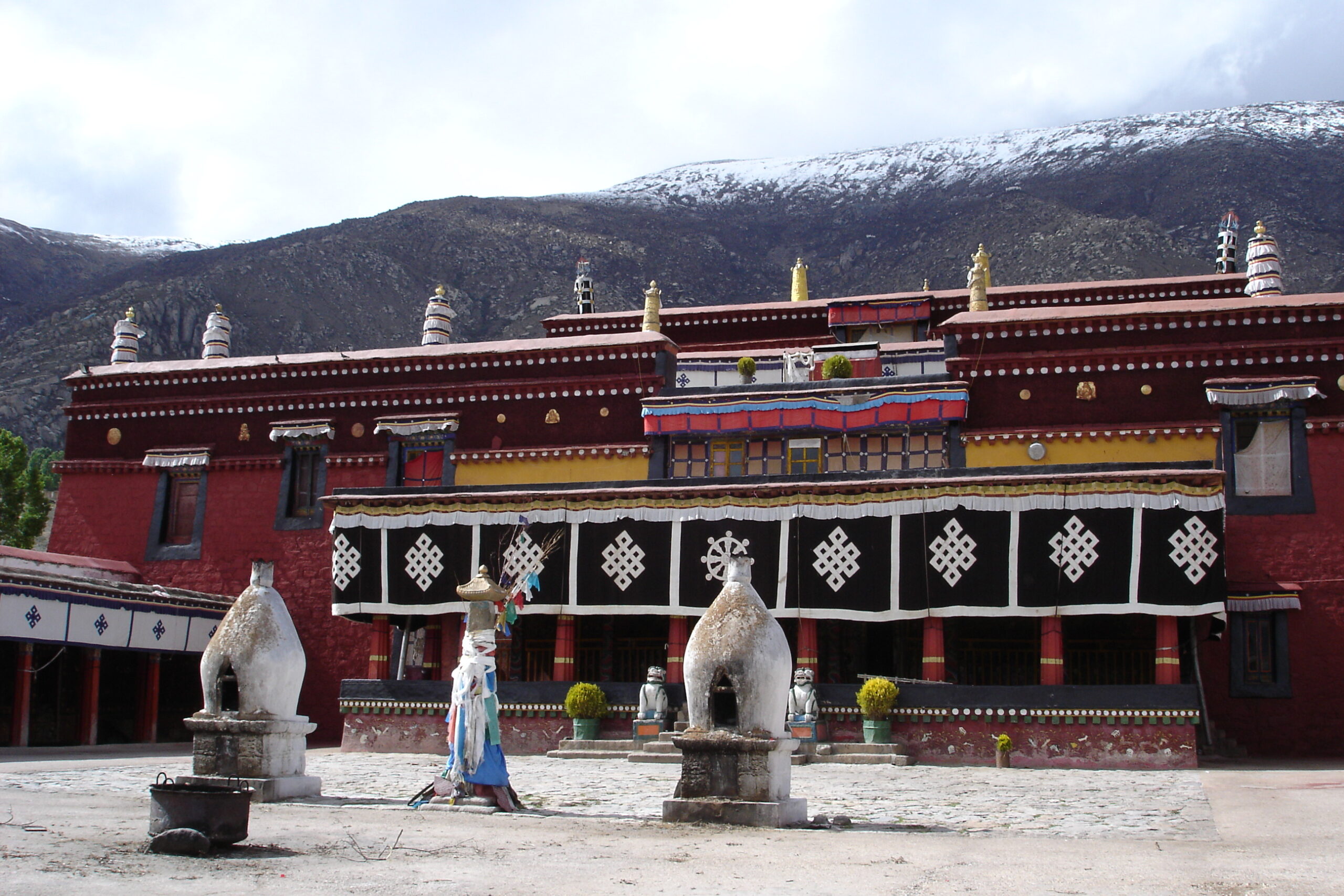
Picture yourself walking through an ancient building, each room filled with graphic images of tortured bodies, bloody rivers, and wrathful spirits. This isn’t a haunted house—it’s Nechung Monastery in Tibet.
At Nechung, visitors can view Tibetan Buddhist artwork in its original context. Although the thought of the monastery’s horrific murals may send shivers down your spine, the images serve as tools to aid a practitioner on the path to enlightenment. Seeing art in its ritual environment is an incredible experience. So, instead of traveling to Lhasa, join Tibetan Buddhist scholar Christopher Bell in a journey through Nechung, ending in the sacred inner sanctum, and learn how the art on display is meant to spiritually transform those that walk down the monastery’s halls.
Nechung Monastery: A Cosmic Realm
A Tibetan Buddhist monastery isn’t just a building; it’s a cosmic realm. In a monastery you often catch sight ofmurals depicting past masters and scenes related to the lives of saints, statues of tantric divinities and wrathful deities, and hanging paintings of maṇá¸alic realms and mythic founders. Less obvious are the paintings of serpent spirits and dragons coiled around pillars, or ferocious faces and elaborate elemental patterns coating the interstices between roof beams. Here you are surrounded by cosmic beings, enlightened masters, and fierce protectors, an entire world and lineal history mapped out on every structure. While this feeling differs from building to building, often based on how well they were patronized, this is especially true of Nechung Monastery, the palace of the Dharma Protector Pehar, an oracle that historically advised the Dalai Lama in his governing of Tibet and Tibetan Buddhists.
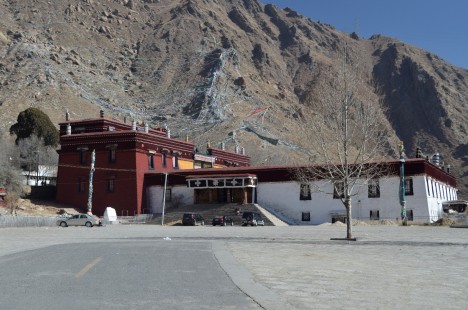
Entering the Courtyard
Nechung Monastery is nestled in the foothills of Mount Gepel on the way to Drepung Monastery, on the outskirts of Lhasa. While a small suburb has been built up around Nechung, it is still an imposing structure set against the mountainside. As you enter the walled courtyard—usually through the above western gate—you are surrounded by an extensive gallery of murals depicting nearly 200 distinct worldly deities and local spirits, all members of Pehar’s vast retinue. In the top register of these murals there is a border of hanging human and demon skins, while the bottom register holds an ocean of blood where human body parts float in various degrees of putrefaction. The intricacies of these murals are unique for a monastery and provide our first glimpse at a vivid realm of wrathful beings.
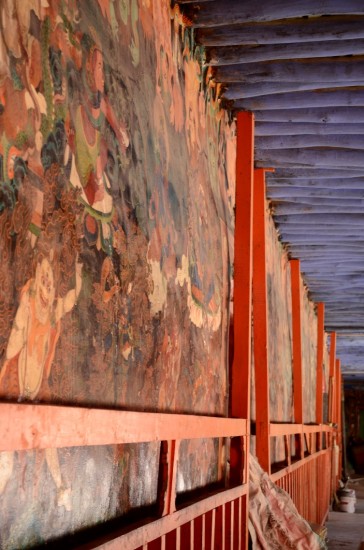
Through the Monastery’s Assembly Hall
At the north end of the courtyard are the main gates into the monastery’s assembly hall, where Nechung’s monks gather to perform major annual rituals. Once again the walls are covered in murals, this time, of beings much larger and much more central than the extraneous deities of the courtyard. The southern half of the assembly hall murals, which you first encounter upon entering the building, include images of past Nechung Oracles and the Five Sovereign Spirits—referring to Pehar and the four other major deities that emanate from him. As you move toward the back of the assembly hall, the murals illustrate more cosmic beings, specifically the eighth-century tantric exorcist Padmasambhava (also known as the “second buddha”) and the transcendent tantric deities called the Eight SÄdhana Deities. The order of these images represents a clear movement along a south-north axis from the profane world of mundane deities to the sacred realm of enlightened beings.
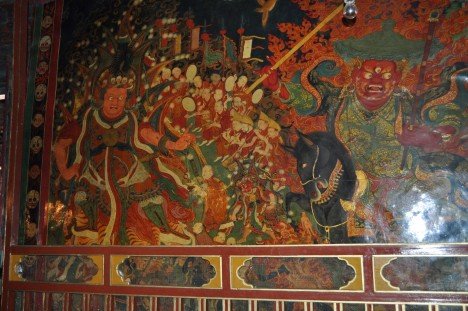
Arriving at the Inner Sanctum
From the assembly hall, you can walk into side chambers and upper chambers—as well as a large chamber behind the monastery that holds a two-story statue of Padmasambhava—but the sacred focus of the monastery points to three back shrine rooms.
The small western back shrine room holds several statues and Pehar’s historic soul tree, while the eastern back shrine room holds statues of several goddesses associated with Pehar. The central back shrine room is the inner sanctum of the entire complex, the very heart of Nechung. The wall of this chapel is covered by an array of statues of the Five Sovereign Spirits and important Nechung goddesses. However, the statue at its very center depicts a nineteenth-century Nechung Oracle named ÅšÄkya Yarpel (fl. 1856-1900). This is significant because historically this chapel room housed the Nechung Oracle himself during trance sessions, bringing Pehar and his emanations temporarily down to earth to interact with the Tibetan government and members of the surrounding community.
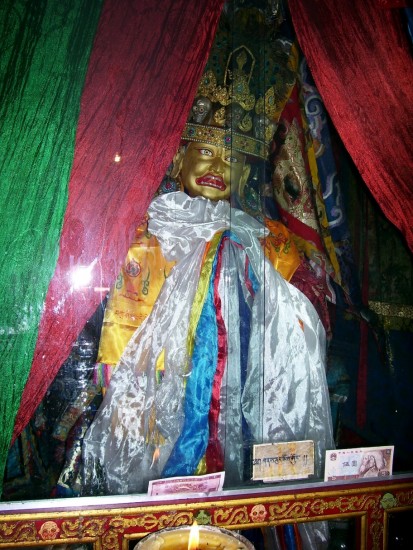
Artwork That Houses the Cosmic Realm
When viewed as a whole, Nechung Monastery evinces a powerful mythology. As you move from the courtyard to the assembly hall to the central chapel, you are cosmically moving from the fringes of Pehar’s entourage into the presence of the Five Sovereign Spirits and the goddesses associated with them before having an audience with Pehar himself in all his ferocious glory. Furthermore, this interaction is overseen by transcendent tantric deities and the Second Buddha himself, Padmasambhava. The result is a terrifying realm, a dark divine palace surrounded by an ocean of blood and decorated with flayed skins. Nevertheless, this is the mansion that houses a god that has advised the Dalai Lama on state and ritual matters since the sixteenth century.
Nechung Monastery’s horrifying character speaks to its tantric origins, where an antinomian appeal to saṃsÄric traits like fear and disgust aid in one’s nirvÄṇic goals. In keeping with this, the Five Sovereign Spirits themselves are considered by Nechung’s lineage to be representations of the Five Buddha Families, as explained in the wall inscription on the south wall of the monastery’s courtyard. As tantric deities in the guise of worldly beings, the gods of Nechung inhabit the monastery on multiple levels, and they are just as present as the monks that live there.
If you can’t visit Nechung in person, you can learn more and see images of the Monastery in Monumental Lhasa: Fortress, Palace, Temple, on view until January 9, 2017. See more sacred art in a re-created ritual context in the Tibetan Buddhist Shrine Room.
About the Author
Christopher Bell, Ph.D., is an Assistant Professor of Religious Studies at Stetson University. He received his B.A. in creative writing and religions and his M.A. in religious studies from Florida State University. He received his doctoral degree from the University of Virginia in 2013, where his area of concentration has been in Tibetan and Buddhist studies. His research currently focuses on Tibetan deity cults and rituals.

